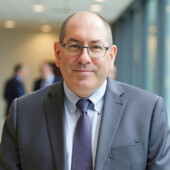00:00:00.000 --> 00:00:06.000
[Speaker: Dr. Tony Vine.]
[Visual: Dr. Vine in his medical office speaking to the camera.]
[Music: Soft, inspirational music begins.]
Hi, I'm Dr. Tony Vine. I'm a laparoscopic
surgeon, so I do minimally invasive surgery,
00:00:06.000 --> 00:00:13.000
[Visual: Illustration of the digestive tract.]
involving the intestinal tract all the way
from the esophagus down to the anus.
00:00:13.000 --> 00:00:22.000
[Visual: Dr. Vine walking through the hallway of his
medical practice and into his office.]
How I came to medicine was really through my father.
I asked him if he wanted me to take over his dental practice.
00:00:22.000 --> 00:00:30.000
[Visual: Photo of Dr. Vine smiling with his elderly father.]
And he said to me, “For the four years that you go to dental school,
you may as well go to medical school and learn the whole thing.”
00:00:30.000 --> 00:00:38.000
[Visual: Photo of Dr. Vine standing wearing blue scrubs.
Then, Dr. Vine speaking to the camera.]
I have been practicing medicine for approximately
30 years.
00:00:38.000 --> 00:00:47.000
[Visual: Photo of Dr. Vine with former classmates
at Vanderbilt Medical School.]
I graduated from Vanderbilt Medical School in 1989, and started
at Mount Sinai for my residency in that same year…
00:00:47.000 --> 00:00:54.000
[Visual: Back to Dr. Vine speaking directly to
the camera]
…and did two years of research in the middle of
my residency at Massachusetts General Hospital.
00:00:54.000 --> 00:01:03.000
[Visual: Mount Sinai graduation photo of
Dr. Vine with classmates and professors.]
Came back to Sinai in 1994 and graduated
as a chief resident from there in 1996…
00:01:03.000 --> 00:01:10.000
[Visual: Photo of Dr. Vine performing surgery in blue scrubs.]
…and immediately started work in July of 1996.
00:01:10.000 --> 00:01:16.000
[Visual: Dr. Vine, smiling and speaking to the
camera, then a photo of Dr. Vine playing violin in green scrubs.]
In my spare time,
whatever little there may be of it,
you can find me practicing my violin.
00:01:16.000 --> 00:01:24.000
[Visual: Video of Dr. Vine at desk.]
[Visual: Then, photos of Dr. Vine with NY State Senators.]
You might find me preparing for a meeting
with a New York State Senator for lobby day.
00:01:24.000 --> 00:01:29.000
[Visual: Photo of Dr. Vine with one of
his chief residents.]
You might find me teaching the
medical students and residents.
00:01:29.000 --> 00:01:34.000
[Visual: Photo of Dr. Vine with a chief resident.]
I think that my humanistic background,
having been an English major in college,
00:01:34.000 --> 00:01:44.000
[Visual: Video of Dr. Vine playing with the orchestra.
Music: Background music fades out.
Sound of Dr. Vine playing the violin begins.]
being a violinist, I feel that I come to medicine
with more of a humanistic, compassionate approach.
00:01:44.000 --> 00:01:49.000
[Visual: Dr. Vine speaking to camera.
Music: Violin music fades out.
Original background music resumes softly.]
I really try and treat my patients as if they were my family members.
00:01:49.000 --> 00:01:54.000
[Visual: Fade to black.
Music fades out.]
Gallstones
Gallstones form in the gallbladder, which is a small, hollow organ that is a little bit bigger than your thumb pad, located just below the liver. The gallbladder plays an important role in how our digestive system functions, by storing bile produced in the liver and releasing it when it’s needed for digestion. Bile then moves through bile ducts into the small intestines to help break down fat from food, and is reabsorbed at the very end of the small intestine.
Gallstones, which range in size from a grain of sand to a golf ball, are hard, pebble-like deposits that form when substances in the bile become unbalanced.
Types of Gallstones
- Mixed stones – the most common type of gallstones, made up of of cholesterol and salts
- Cholesterol stones – form primarily from hardened cholesterol
- Pigment stones – these are very rare and are smaller stones that form when there is an excess of bilirubin, a substance produced when the liver breaks down red blood cells. Pima Indians are the most common group to have this type of stone.
While many people with gallstones have no symptoms, others require medical treatment or surgery to remove the gallbladder if the gallstones block the outlet of the gallbladder, pass into the bile ducts, or pass into the duodenum. This could lead to inflammation of the gallbladder, jaundice (choledocholithiasis – stones in the bile duct) or pancreatitis.
Gallstones Symptoms
- Pain – sudden, sharp pain in the upper right abdomen under the rib cage, which sometimes radiates to the back or shoulder
- Nausea or vomiting
- Fever or chills
- Bloating or indigestion
- Jaundice
- Clay-colored stools
- Diarrhea
- Dark Urine
Dr. Anthony Vine has performed successful laparoscopic gallbladder surgery (cholecystectomy) on many patients suffering from gallstones.
He is an Attending Surgeon and Associate Clinical Professor of Surgery at the Icahn School of Medicine at Mount Sinai Hospital. His office is located at 1010 5th Avenue at the Laparoscopic Surgical Center of New York.
Learn more about Laparoscopic Gallbladder Surgery and recovery time.

